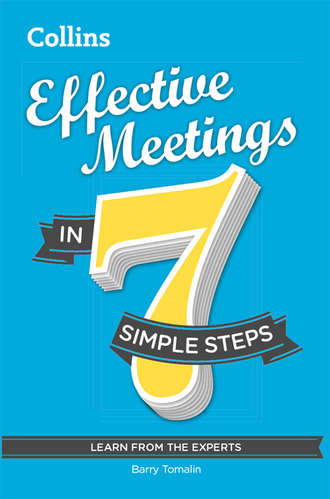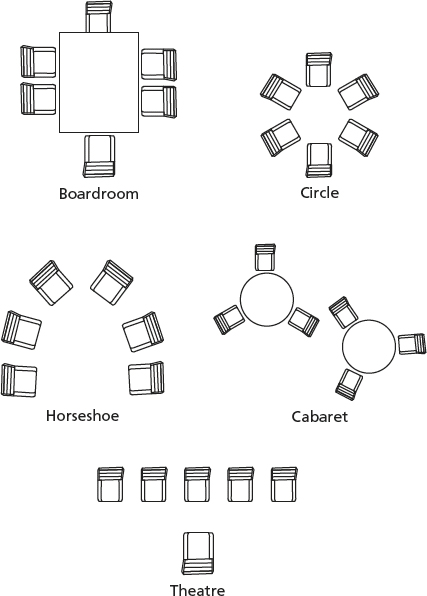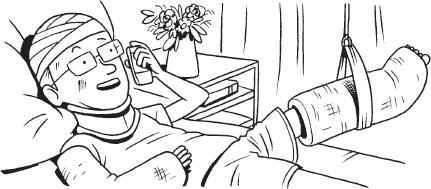
Полная версия
Effective Meetings in 7 simple steps
What had changed? The meeting leader was convinced of one thing. Sitting round a table in a circle diminished the atmosphere of confrontation and increased the willingness to cooperate.
Meeting room layouts

As a final thought, have you ever watched The Apprentice? Think what you’ve learned about meeting organisation and room layout – how does it apply to what you’ve seen on the show? At first, it’s lovey dovey. Lord Sugar arrives in his Bentley. He stands in front of the teams, mixes them up and gives them the task. Fifty minutes later, it’s another story. He sits at a desk in front of a frosted glass door, flanked by his cohorts. Opposite him in two rows sit or stand the two teams. There aren’t enough seats for everyone.
It’s a mixture of theatre style, in this case more like a classroom, and facing rows. The two teams aren’t actually facing each other, but it feels very oppositional – almost like a courtroom. The layout seems designed for maximum superiority (Lord Sugar) and maximum humiliation (the contestants).
This is nothing to do with Lord Sugar, but everything to do with the production values which, Big Brother style, try to create tension and conflict in order to build audiences. The age of the gladiator is not dead! But it’s exactly the wrong way to set up and run a meeting.
Imagine if the approach was cooperative and aimed at showing everyone at their best. People would sit next to, not opposite each other. They would discuss in a circle, a horseshoe or cabaret style, not in facing rows. Lord Sugar and his cohorts would sit among the contestants, not apart from them.
Layout determines whether the atmosphere will be collaborative or confrontational.

So let’s imagine you are asked to organise a meeting. What? No! That’ll never happen to you! Well, actually it might. An intern was asked to organise the weekly management meeting. Why? It was a good way to test her organising skills and her willingness to take responsibility and use her initiative. She came through with flying colours and, as a result of this and her other work, got an offer of a permanent job.
What did she do? She used the framework. Five W’s and an H:
WHY? First she asked why the meeting was necessary. What was it intended to achieve?
WHAT? Then she checked the topic. That would go on the invitation.
WHO? Then she asked who needed to be invited, names and job titles. She double-checked these. (Her life would have been a misery if she had got them wrong!)
WHEN? Her line manager suggested a time, but she needed to check alternatives. She used a time chart to check everyone’s availability and found a date and time that suited everyone.
WHERE? She had to decide whether to hold the meeting in the office or outside the office. In the event, her line manager preferred the office. So she booked a room, checked it, moved the tables and chairs around, ensured there was a data projector and booked tea, coffee, biscuits and a sandwich lunch from the canteen.
HOW? What needs to happen?
Having decided on the Why, What, Who, When and Where, the intern finally had to deal with the How. What did she need to do?
1 Book a room.
2 Send out the invitations.
3 Chase up anyone who hadn’t replied.
4 Circulate the agenda and any papers to be ‘tabled’ (discussed).
5 Chase up anybody who hadn’t replied (there’ll always be a few).
6 Check the room was OK for the meeting. Raid the stationery cupboard (for any pens/paper the participants will need).
7 Telephone attendees to remind them.
8 Make a note of those who would be absent or would have to leave early.
9 Prepare the agenda (see Step 2).
How does this apply to you?
As the intern realised, organising a meeting is both a challenge and an opportunity. If you get the opportunity, how do you meet the challenge? First, find out what has been done before. Ask more experienced colleagues or your line manager.
Secondly, think of your own experience. If you’ve participated in meetings before, is there anything you can use? Thirdly, don’t worry about inexperience. This is an opportunity to learn. It’s also an opportunity to show you can take responsibility and show initiative.
Lastly, after the meeting, take time to reflect. What have you learned from the experience? What will you do, say, and above all, think in the future? Learning to reflect on your experience and learn lessons for the future is one of the most important things you can do as an employee.
Key take-aways
Think about the things you will take away from Step 1 and how you will implement them.
Topic Take-away Implementation How to assess whether meetings are relevant • Not all meetings are relevant. Some are just routine. • Ask my line manager to prioritise. How to make the most of meetings you have to attend How to recognise types of meeting How to keep meetings shorter How to write a good meeting invitation How to decide who to invite How to check availability How to make sure the room is suitable How to organise a meeting practically How to manage what you have learnedStep 2
PREPARE USEFUL DOCUMENTS
‘Whoever controls the minutes, controls the meeting!’ — UK finance manager
Five ways to succeed
Always have an agenda.
Communicate the aim and objectives.
Organise the discussion documents for the meeting.
Know how to present your own ideas.
Take and present minutes to suit the meeting.
Five ways to fail
Assume the meeting can run by itself.
Waste time by not organising/attaching discussion papers.
Fail to ask someone to take the minutes.
Write down what everyone says and then try to reproduce it.
Forget to check minutes before circulation.

Good meetings depend on planning and successful planning depends partly on good documentation.
Four key documents will contribute to a successful meeting. They are:
The invitation
The agenda
Supporting papers and discussion documents
The minutes
The invitation makes sure you get the right people in the right place on the right day at the right time.
The agenda is your roadmap to success. It is the path to meeting the goals and objectives of your meeting. It ensures you clarify your meeting objectives and it identifies the process you need to go through to achieve them with the relevant stakeholders.
The supporting papers and discussion documents provide the necessary background to any discussion, but need to be presented in an unambiguous and accessible way.
The minutes are not just a record of the meeting. They are an action plan going forward.
Clear, relevant and action-oriented action points provide the platform for the next steps.
There should be a clear progression from the agenda to the minutes. The order of the minutes should reflect the order of the agenda and should clearly relate to the subject headings and issues raised in each item. If it doesn’t, you risk confusion.
The invitation
When you prepare an invitation, you tell attendees about the meeting: where they need to go, what date and what time.
Sounding pro: Meeting invitations
Here’s an example of an invitation:
To:
From:
Re: Team meeting
Dear Colleagues,
We are holding two meetings in May to discuss reorganisation of the department. It is extremely important that everyone in the team attends. We are proposing two dates: May 17th or May 24th at 1 p.m. in the canteen. Please let me know by May 6th which date or dates you are available for.
I look forward to hearing from you. Thank you.
Sara Leboeuf
HR Manager
Why is this invitation successful?
It’s clear – it states the type of meeting.
It explains – it doesn’t take for granted that the participants know.
It specifies attendance – it says who should come.
It offers alternative time slots.
It offers a choice of dates.
It’s polite and it makes clear requests with a clear deadline.
It shows authority – the sender states her job title at the end.
The invitation also creates a record. Do people need a record? If you’ve got back-to-back meetings or very few meetings, yes, you do. Knowing where you have to be and when is all important.
Date
Write it how you like. Some people prefer May 6th 2013. Some like 6th May 2013. Many people, even in the UK, use the US form 6 May 2013 or May 6 2013.
You may see this: 6/7/13 (the 6th of July 2013), but be careful, as in America and other parts of the world, the month comes first, like this: 7/6/13 (the 6th of July 2013) not, as it looks to the British (the 7th of June 2013).
If in doubt, copy the format from a previous meeting.
Time
Just to be clear, many companies now use the 24-hour clock and write the time as part of a 24-hour period. So 09:05 is five minutes past nine a.m. and 12:05 is five minutes past 12 o’clock midday. Alternatively, you can use a.m./p.m.
It’s important to note that people from different cultures have different attitudes to time. Some are much more tolerant of delays and lateness than others. The UK, by and large, is an ‘on time’ culture. It’s much better to arrive five minutes early for a meeting than five minutes late. Also, if you’re going to be late you should ring and advise as early as possible.
Location
This is straightforward: building, address (if needed) and room number, e.g.
Room 101 Edinburgh Building 3 East Side Nottingham
Be careful you get numbers and addresses right. If the meeting is in your office building, check the room booked corresponds to the room number on the invitation and agenda.
If the meeting is off-site (i.e. away from the office), check the directions (they are sometimes called joining instructions) are easy to follow. Do get it right. It’s all too easy to send people to the wrong room or even to the wrong building on the wrong side of town!
Check and double-check the details are right. If you’re in the same building, nip along and check. Fifteen minutes spent now might save hours of wasted time and frustration later – for you and the participants. After all, you don’t want to end up on the roof!

Requesting items for inclusion
Sometimes the invitation may include a request for items to be discussed by the participants. Imagine this situation. You had an action point from the last meeting that you haven’t been able to complete. So you want to have further discussion in the next meeting. The best way to do this may be to put it on the agenda for the meeting.
It’s worth asking all participants if they want to include this or perhaps another item. You can either do this when you send out the invitation or else in a separate email, once the meeting date has been agreed.
Date: All addressees: Subject: Agenda items for meeting on 28th March
Dear all, Please let me have any agenda items for the meeting on 28th March by 5 p.m. on 25th March.
Thank you very much. Tom Hadfield
Types of meeting
Before we go on to the next piece of documentation, the agenda, let’s make a distinction between two types of meeting. The first is the regular meeting. This is a meeting of a project team or department which takes place at regular intervals, weekly or monthly. The aim of the meeting is primarily to update on progress and troubleshoot problems. This is the kind of meeting where the meeting leader may request items for inclusion, as above.
The second is a ‘one-off’ meeting to discuss a particular topic or issue. In this case, there has been no ‘last meeting’ and therefore it’s unlikely, though not impossible, that the meeting leader will request items for inclusion.

Agendas are the single organising principle of a business meeting. They define what needs to be discussed and in what order. They are therefore the starting point for any successful meeting, and the lack of one is the main starting point for an unsuccessful meeting. But they also have another function. They help you organise your thoughts. When you write an agenda, automatically you think about what you want to agree on. These are the aims and objectives of the meeting.
If you look around, you’ll see business people in informal meetings in coffee shops, cafés and restaurants. Even for informal meetings they’ll ask the question, ‘What do we need to discuss?’ And they will scribble the points to discuss on a napkin or piece of paper. It may not look like it, but that’s an agenda.
The way to focus a meeting is through the agenda. Agendas help you think more constructively and more logically about what you want to achieve. It’s not just about organising your thoughts. It’s also about deciding what order you want to present them in – the progression. Going into a meeting without a clear agenda is like going into a meeting without a focus.
Agendas – what to include
Agendas are often included with the invitation. They normally include the following information:
Details of meeting, date, time, location
See here and here.
Participants
This is a list of who is expected at the meeting, the participants. At the very least, write their names, but some agendas include job titles too.
Once again, your policy should be to look at a previous agenda and check how people are described. Use that as your guide. Expect at least the full first name and family name, e.g. Barry Tomalin.
In more formal meetings, titles may be attached, e.g. Mr Barry Tomalin, M.A. However, check gender. Is Hilary Baker a man or a woman? Check company policy. Mentioning gender titles may be politically incorrect.
In some cases, job titles may also be added, e.g. Alicia Jones, R&D Coordinator EMEA.
So here is your next problem, acronyms. What does an R&D Coordinator do? And what is EMEA? R&D is Research and Development, in other words, a researcher. EMEA defines the region of responsibility. It stands for Europe, Middle East and Africa. Part of your background research is to note the names (people you may never meet but you are expected to know who they are), their job titles and the acronyms that describe their areas of responsibility. Information may be found on the company intranet. Never be afraid to ask about this, especially during your first few months in the company. But don’t be surprised – they may not know either!
Apologies for absence
Some people don’t turn up for meetings and they don’t tell anyone beforehand. In Britain, in particular, this is not well viewed, and in France they call it absence sauvage: ‘savage absence’. If you can’t make a meeting, you should always email or phone in good time. If it’s a short notice cancellation or delay, make sure you phone.
If by any chance you miss a meeting and don’t inform the meeting leader, then you should apologise by phone or email as soon as possible afterwards.
On the agenda, absence is noted like this:
Apologies
Barry Tomalin
Or:
Apologies received Barry Tomalin
Or:
Apologies received from Barry Tomalin
If you’ve sent your apologies in advance, then you should be on the list to receive the minutes of the meeting. If for any reason you don’t receive them, then you should ask for them.

Minutes of last meeting
For a regular meeting, when you send out the invitation to the next meeting, you should usually attach the minutes of the previous meeting. That way everyone can check what has and hasn’t been done since the last meeting.
Agenda items
Each item on the agenda has a title, for example:
1. Project update (Claire) – (7 minutes), Paper 2.1
Check company practice in the presentation of items.
- Is an ‘item owner’ listed? In this case, Claire introduces the update, followed by discussion.
- Is there a suggested time? This proposes a theoretical duration for the presentation and discussion. It helps the meeting leader keep track of time, so he/she can shorten the discussion or cut another item lower down the list. Also, it helps the item owner, Claire, know how long she is expected to take.
- Are there supporting papers? If so, it may be useful to list these so that participants know which paper refers to which item.
The number of items on the agenda depends on the time available and the number of issues to be discussed. But an agenda of seven items in a 60-minute meeting would be ample.
Supporting papers may be of different types. They might include financial statements, product specifications and descriptions, and position papers on issues of policy or strategy. They can be added to the agenda and circulated with it as hard or soft copy. Be sure to have hard copies on hand for participants who haven’t printed out the soft copy!
Конец ознакомительного фрагмента.
Текст предоставлен ООО «ЛитРес».
Прочитайте эту книгу целиком, купив полную легальную версию на ЛитРес.
Безопасно оплатить книгу можно банковской картой Visa, MasterCard, Maestro, со счета мобильного телефона, с платежного терминала, в салоне МТС или Связной, через PayPal, WebMoney, Яндекс.Деньги, QIWI Кошелек, бонусными картами или другим удобным Вам способом.




